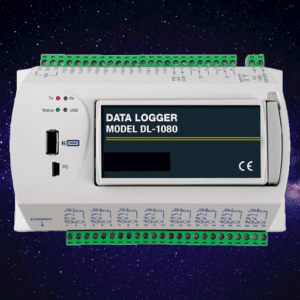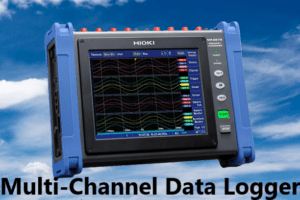A data logger, in its essence, is a remarkable technological tool designed to capture and record valuable information over a period of time. Acting as a silent observer, a data logger diligently collects and stores data from various sources such as sensors, instruments, or devices. This compact device is equipped with sensors or inputs to measure and log parameters like temperature, humidity, pressure, voltage, or any other relevant data points.
What is data logger
Data loggers are with the ability to autonomously collect data in real-time or at predefined intervals, a data logger serves as a trustworthy companion in numerous fields and industries. From scientific research and environmental monitoring to industrial processes and quality control, data loggers play a pivotal role in providing accurate and reliable data for analysis, evaluation, and decision-making purposes. The captured data is typically stored within the data logger itself or on external storage media, such as memory cards or USB drives. Depending on the complexity and capabilities of the device, data loggers may also offer additional features such as wireless connectivity, data transmission, and compatibility with software for data visualization and analysis.

The versatility of data loggers allows them to be deployed in a wide range of environments and applications. For example, in agriculture, data loggers can monitor soil moisture levels, light intensity, or weather conditions to optimize crop growth. In the transportation sector, they can track parameters like speed, location, and fuel consumption for fleet management and efficiency improvement. In scientific research, data loggers are used to gather data for experiments, ensuring precise measurements and accurate results.
By employing data loggers, researchers, engineers, and professionals gain access to a wealth of information that enables them to make informed decisions, uncover trends, detect anomalies, and improve processes. The invaluable data collected by data loggers serves as a foundation for analysis, offering insights and supporting critical assessments that contribute to advancements in various industries.
Specifications of Data Logger
| Specification | Description |
|---|---|
| Measurement Inputs | Sensors or probes supported by the data logger |
| Supported Parameters | Temperature, humidity, pressure, voltage, etc. |
| Measurement Range | Minimum and maximum values the data logger can measure |
| Accuracy | Degree of precision in measurements |
| Resolution | Smallest increment in measurements |
| Sampling Rate | The temperature range in which the logger can operate |
| Memory Capacity | Amount of data that can be stored in the logger |
| Power Source | Battery-powered or external power options |
| Communication | Interfaces for data transfer (USB, Bluetooth, Wi-Fi) |
| Display | LCD screen for viewing measurements and settings |
| Software Compatibility | Compatibility with data analysis and visualization software |
| Operating Temperature | Temperature range in which the logger can operate |
| Dimensions | Physical size and weight of the data logger |
| Durability | Resistance to environmental factors and ruggedness |
| Certifications | Compliance with industry standards or regulations |
Temperature Data Logging
Temperature, a fundamental aspect of our surroundings, influences various domains, from manufacturing processes to climate control. A temperature data logger is a specialized device designed to continuously measure and record temperature variations in a given environment. Equipped with highly accurate sensors, these loggers enable us to track temperature trends, detect anomalies, and establish patterns over time. By monitoring temperature changes, industries can optimize processes, ensure product quality, and create comfortable environments for occupants.
Unveiling Moisture’s Secrets: Humidity Data Logging Humidity, the measure of moisture content in the air, plays a crucial role in diverse settings, including agriculture, manufacturing, and indoor comfort control. Humidity data loggers provide a means to monitor and comprehend this vital parameter. These devices employ sensors specifically designed to capture and record humidity levels accurately. By analyzing humidity data over time, industries can prevent mold growth, optimize drying processes, and maintain ideal conditions for sensitive materials or products.
The Power of Integration: Temperature and Humidity Data Loggers In many scenarios, understanding the relationship between temperature and humidity is essential. Temperature and humidity data loggers, equipped with dual sensors, offer synchronized measurements of these parameters. This integrated approach allows for a comprehensive understanding of environmental dynamics. Industries such as HVAC, food storage and transportation, agriculture, and pharmaceuticals benefit greatly from the insights provided by these loggers. With the ability to monitor both temperature and humidity simultaneously, professionals can optimize processes, ensure product quality, and create ideal conditions for various applications.
Applications Across Industries: Enhancing Control and Efficiency The applications of temperature and humidity data loggers span across a wide range of industries. In agriculture, these devices help monitor and regulate greenhouse conditions, optimize irrigation, and prevent crop diseases. In the food industry, temperature and humidity loggers ensure compliance with storage regulations, preventing spoilage and maintaining product quality. HVAC systems rely on these loggers to monitor and adjust indoor climate conditions for comfort and energy efficiency. Moreover, in laboratories and manufacturing facilities, temperature and humidity data loggers assist in process optimization, quality control, and environmental monitoring.
Advancements and Benefits: Driving Progress Continual advancements in temperature and humidity data logger technology have led to improved accuracy, increased memory capacity, extended battery life, and enhanced connectivity options. These advancements empower industries with more precise and reliable data, facilitating better decision-making and control. By utilizing temperature and humidity data loggers, businesses can reduce costs, optimize processes, ensure compliance with regulations, and improve overall efficiency.
Applications of the Data Logger
| Application | Description |
|---|---|
| Environmental Monitoring | Monitoring temperature, humidity, and other environmental factors in research facilities, greenhouses, weather stations, etc. |
| Industrial Processes | Tracking and optimizing temperature, pressure, and other variables in manufacturing, chemical processing, and industrial automation. |
| Food Safety and Storage | Monitoring temperature and humidity in food storage facilities, refrigerators, and transportation to ensure compliance with safety regulations and prevent spoilage. |
| HVAC Systems | Optimizing heating, ventilation, and air conditioning systems by monitoring temperature, humidity, and air quality to ensure comfort and energy efficiency. |
| Energy Management | Monitoring energy consumption, temperature, and occupancy patterns in buildings to identify energy-saving opportunities and improve efficiency. |
| Research and Development | Gathering data for scientific experiments, testing, and analysis in various fields such as biology, chemistry, physics, and engineering. |
| Cold Chain Monitoring | Tracking temperature during the transportation and storage of perishable goods, pharmaceuticals, vaccines, and other temperature-sensitive products. |
| Agriculture | Monitoring soil moisture, temperature, and weather conditions to optimize irrigation, prevent diseases, and improve crop yield and quality. |
| Quality Control | Monitoring and recording parameters such as temperature, humidity, and pressure to ensure product quality and compliance with standards in manufacturing and production processes. |
| Building Performance | Assessing and monitoring temperature, humidity, and energy usage in buildings to optimize performance, comfort, and occupant well-being. |
Data logger software
- LabVIEW: LabVIEW is a powerful graphical programming software widely used in scientific and engineering applications. It offers data logging and analysis capabilities, allowing users to create custom data logging applications with real-time data visualization and analysis.
- MATLAB: MATLAB is a high-level programming language and environment specifically designed for numerical analysis, data visualization, and algorithm development. It provides a wide range of tools and functions for data logging, manipulation, and analysis.
- Python: Python is a versatile programming language that offers numerous libraries and packages for data logging and analysis. Libraries such as pandas, NumPy, and matplotlib provide robust capabilities for data manipulation, analysis, and visualization.
- DASYLab: DASYLab is a drag-and-drop data acquisition software that allows users to build custom data logging applications without programming knowledge. It offers a range of modules for data visualization, analysis, and control.
- NI-DAQmx: NI-DAQmx is a software suite developed by National Instruments for data acquisition and control. It provides a comprehensive set of functions and drivers for configuring, logging, and analyzing data from various data acquisition devices.
- Excel: Microsoft Excel is a widely used spreadsheet software that can also be used for basic data logging and analysis. It offers built-in functions and charting capabilities for visualizing and analyzing data.
- Grafana: Grafana is an open-source platform used for data visualization and monitoring. It can be integrated with various data logging systems to create dynamic dashboards and visualizations for real-time data analysis.
- Tableau: Tableau is a popular data visualization software that enables users to connect to various data sources, including data loggers, and create interactive visualizations and dashboards for data analysis and reporting.
These are just a few examples of data logger software programs available in the market. The choice of software depends on specific requirements, compatibility with data loggers, and the desired level of analysis and visualization capabilities.
Frequently Asked Questions
What is the purpose of using data loggers in the pharmaceutical industry?
Answer: Data loggers in the pharmaceutical industry are used to monitor and record critical environmental parameters such as temperature, humidity, and pressure to ensure compliance with regulatory requirements, maintain product integrity, and ensure patient safety.
What is the acceptable temperature range for pharmaceutical storage, and how do data loggers help in monitoring it?
Answer: The acceptable temperature range for pharmaceutical storage varies depending on the specific product. Data loggers continuously monitor temperature within storage areas, providing real-time alerts and precise records of temperature deviations, ensuring that pharmaceuticals are stored within the specified range.
How do data loggers assist in the validation of temperature-controlled shipping containers?
Answer: Data logers are placed inside shipping containers to record temperature conditions during transportation. The data collected helps validate that the temperature remained within acceptable limits, ensuring the quality and efficacy of pharmaceutical products upon arrival.
Can data loggers monitor multiple parameters simultaneously?
Answer: Yes, data logers designed for pharmaceutical applications can monitor multiple parameters simultaneously, such as temperature, humidity, and even light exposure, providing comprehensive data for evaluating storage and transportation conditions.
Are data loggers in the pharmaceutical industry required to comply with specific regulatory standards?
Answer: Yes, data logers used in the pharmaceutical industry must comply with regulatory standards such as Good Distribution Practices (GDP) and Good Manufacturing Practices (GMP) to ensure data accuracy, reliability, and traceability.
How long can data loggers typically store recorded data?
Answer: The data storage capacity of data logers varies depending on the model and configuration. Some loggers can store data for several months to years, allowing for long-term monitoring and auditing.
Can data loggers be integrated with existing monitoring systems or software used in the pharmaceutical industry?
Answer: Yes, many data logers can be integrated with existing monitoring systems or software through various communication interfaces such as USB, Ethernet, or wireless connections, facilitating centralized data management and analysis.
Are data loggers in the pharmaceutical industry calibrated regularly?
Answer: Yes, data logers used in the pharmaceutical industry are typically calibrated regularly to ensure accuracy and compliance with regulatory requirements. Calibration is performed using traceable standards and is essential for maintaining data integrity.
Can data loggers provide real-time alerts for temperature excursions?
Answer: Yes, data logers equipped with real-time monitoring capabilities can trigger alerts through email, SMS, or audible alarms when temperature excursions occur, allowing for immediate corrective actions to be taken.
What are the key considerations when selecting data loggers for pharmaceutical applications?
Answer: Key considerations include accuracy, calibration traceability, data storage capacity, battery life, communication options, compliance with regulatory standards, and the ability to withstand pharmaceutical storage conditions (e.g., temperature, humidity).


